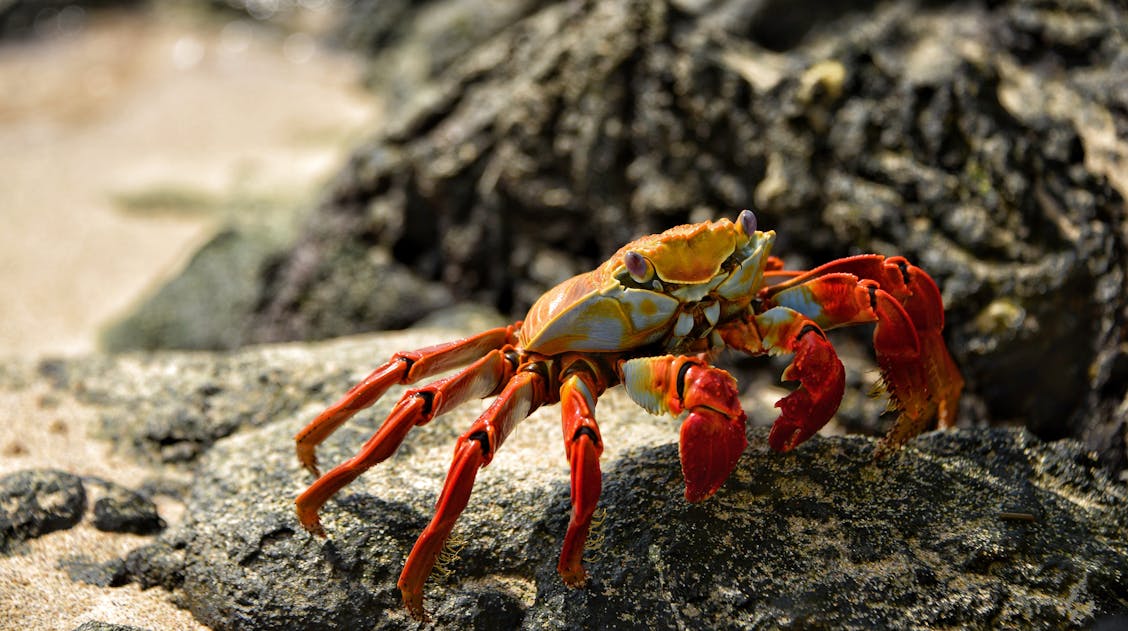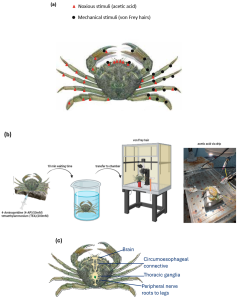
Animal Welfare: Analysing How Crabs Feel Pain
Medical research using animal models has saved millions of lives. Moreover, it continues to play a crucial role in developing treatments and vaccines as well as furthering the understanding of certain diseases. In addition, researchers use animals in medical research to create veterinary treatments for animal conditions.
Animal protection and responsibility surrounding their welfare are crucial for scientific research. Furthermore, issues concerning animal welfare can affect the quality and impact of the research. Animal welfare in scientific experiments has been a topic of discussion for centuries. It has not always been viewed as a priority; however, today the regulation of animal experiments is extremely important. Because of this, scientists are constantly trying to improve the welfare of animals in scientific research and the food industry.
Research recently published in the Open Access journal Biology investigates how shore crabs feel pain, providing a better understanding of these crustaceans that are commonly used in scientific experiments and for food. Here, we explore this important research and how it will impact future research and the food industry.
Awareness of animal sentience
Animal sentience refers to the ability of animals to feel pain, distress, and suffering, as well as being able to experience both positive and negative feelings. The suggestion that animals were capable of sentience like humans was once controversial to the general public and scientific community. However, some researchers began to question the assertion that animals could not feel pain as early as the 1800s.
One of these researchers is Marshall Hall, who in 1831 began to understand and explain the need for ethical justification in an introduction for his volume on Experimental and Critical Essay on the Circulation of the Blood. He did this by describing five principles for the prosecution of physiology, including:
- We should never have recourse to experiment in cases in which observation can afford us the information required.
- No experiment should be performed without a distinct and definite object and without persuasion, after the maturest consideration, that the object will be attained and produce a real and uncomplicated result.
- We should not needlessly repeat experiments.
- That it should be instituted with the least possible infliction of suffering.
- Every physiological experiment should be performed under such circumstances as will secure due observation and attestation of its results and so obviate, as much as possible, the necessity for its repetition.
The 3 Rs: Replacement, Reduction, Refinement
The five principles explained by Marshall Hall brought awareness to animal welfare and later inspired the guidance still used today. Researchers refer to this as the 3Rs: Replacement, Reduction, and Refinement.
The 3Rs were developed and published in 1959 by the Universities Federation for Animal Welfare (UFAW), William Russel, and Rex Burch. UFAW, an independent registered charity, collaborates with the animal welfare science community. Their main goal is to improve the lives of animals in farms, laboratory captivity, and wild captivity.
In 1959, UFAW, William Russel, and Rex Burch published the Principles of Humane Experimental Technique, where they explained the principles of the three Rs:
- Replacement: The substitution for conscious living higher animals of insentient material;
- Reduction: Reduction in the number of animals used to obtain information of a given amount and precision;
- Refinement: Any decrease in the severity of inhumane procedures applied to those animals, which still have to be used.
Replacement advises that researchers should not use sentient animals if non-sentient alternatives are available.
Reduction requires that researchers take time to plan and manage experiments. So that if animals do have to be used, then the minimum number of animals can be used to achieve the research objectives.
Refinement encourages researchers to plan experiments carefully to decrease or mitigate any pain, suffering, or distress that the animals may feel.
Animal welfare today
Animal welfare has greatly improved since researchers developed the 3Rs, which still provide guidance on animal welfare today. The European Union has been building legislation since 1974 for the protection of animal welfare. In addition, the US passed the Animal Welfare Act in 1966 and continues to amend and update it
Other countries around the world have their own set of laws and legislation to protect animal welfare, including Australia, Brazil, and India. However, these laws do not protect all animals; for example, the EU legislation, European Directive 2010/63/EU, currently does not recognize decapods as animals capable of sentience. Because of this, researchers from Sweden and Portugal investigated the nociceptors of decapods to further understanding of pain in crustaceans.
“It is a given that all animals need some kind of pain system to cope by avoiding danger. I don’t think we need to test all species of crustaceans, as they have a similar structure and therefore similar nervous systems. We can assume that shrimps, crayfish, and lobsters can also send external signals about painful stimuli to their brain, which will process this information.” – Eleftherios Kasiouras, author of the paper.
Decapods and animal welfare
Decapods, or Decapoda, are a class of crustaceans that include 8000 species, including crabs, lobsters, shrimps, and crayfish. Scientists commonly use them in experiments, and humans consume them. Currently, there are no minimal animal care requirements for decapods in the European legislation.
However, new legislation in the European Parliament (Committee on Fisheries) revises the protection of animals during transport and related operations (EC, 2024). Decapods are commonly slaughtered using methods that would be deemed unacceptable for vertebrate animals. People often misunderstand the anatomy of invertebrates, and methods they believe will stun and prevent suffering during slaughter instead prolong the process and cause more harm.
“We need to find less painful ways to kill shellfish if we are to continue eating them. Because now we have scientific evidence that they both experience and react to pain”.—Dr. Lynne Sneddon, author of the paper.
Analysing decapod nociceptors
Nociceptors are nerve endings that detect damaging stimuli and send signals to the central nervous system, initiating the sensation of pain. Because of this, the presence of nociceptors is one of the key criteria for assessing pain.
The researchers investigated the existence of nociceptors in shore crabs. They did this by examining their central nervous system (CNS) response to two types of stimuli: mechanical and chemical.
Mechanical stimulation involved using von Frey hairs of 0.1 g, 0.16 g, 0.04 g, and 0.008 g, a tool that uses graded hair or filaments to analyse sensory and pain thresholds. The researchers assessed chemical or noxious stimuli using a range of concentrations of acetic acid. This included concentrations of 0.1%, 0.5%, 1%, and 5%. They stimulated soft tissue areas, including the eyes, antennae, antennules, soft tissue between the claws, and soft tissue at the joints of the pereiopods, using both mechanical and chemical stimulation.
The researchers conducted Electrophysical recordings on the brain or circumesophageal ganglion in response to both mechanical and chemical stimuli.
Furthermore, the researchers injected the crabs with neuromuscular blockers, 4-aminopyridine (4-AP), and tetraethylammonium (TEA) before applying mechanical and chemical stimulation This was to facilitate electrode implantation and uninterrupted recordings.

Presence of decapod nociceptors in shore crabs
The researchers identified that 32 areas of the crab’s body exhibited putative nociceptive responses to a noxious chemical. Additionally, they also identified that many areas of the crabs also exhibited mechanical responses.
They noted that responses to the physical stimuli were shorter and more intense than the chemical stimuli. However they also noted that chemical stimuli elicited a longer response. Furthermore, they also identified that the antennae of the crab responded to only chemical stimuli with no response to mechanical stimuli.
“We could see that the crab has some kind of pain receptors in its soft tissues because we recorded an increase in brain activity when we applied a potentially painful chemical, a form of vinegar, to the crab’s soft tissues. The same happened when we applied external pressure to several of the crab’s body parts.” – Eleftherios Kasiouras, author of the paper.
The researchers conclude that further research is needed in this area to fully understand pain in crustaceans. However, they note that this study provides crucial information on the perception of tissue damage in a crustacean. This information could lead to changes in legislation on crustacean welfare.
If you would like to read more on this topic or submit research, please see the journal Biology’s section Zoology.










